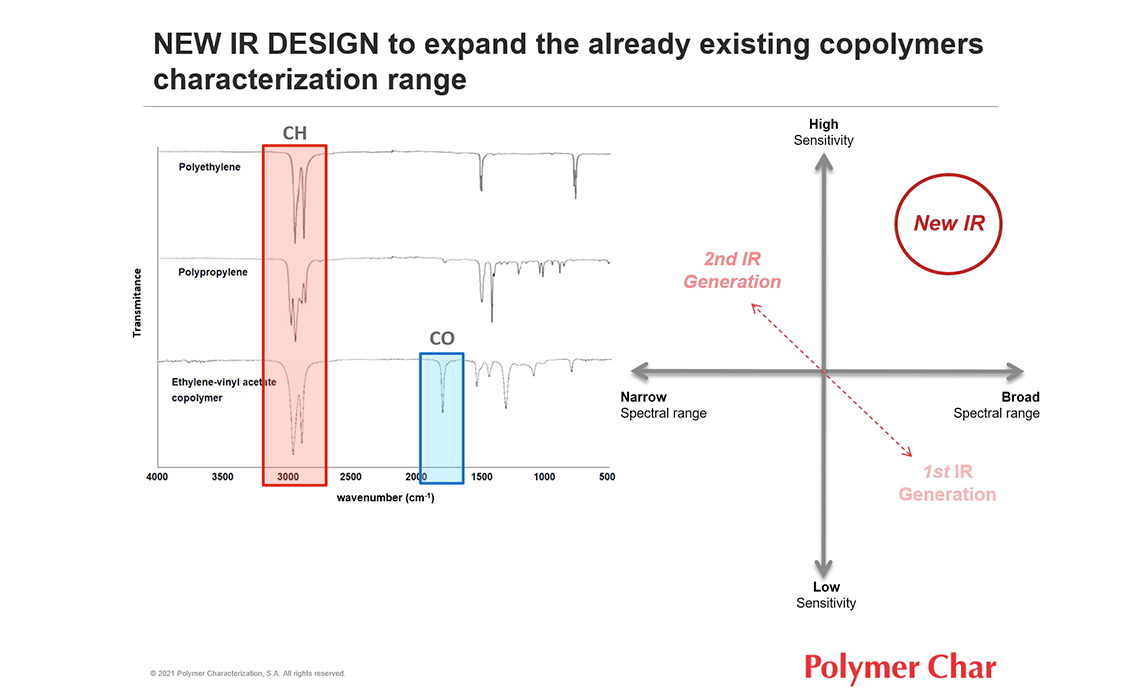Watch the Webinar

Video Access Request
To receive a password by email please check the boxes above and complete the following form. Thank you for your interest.
Presented at SPE International Virtual Polyolefins Conference, 2021
Esther López, Alberto Ortín, Francisco Samper, Benjamín Monrabal
Abstract:
The full characterization of polyolefins requires a high-temperature GPC/SEC analysis to be made with specific detectors. The Infrared (IR) has been extensively used as concentration and chemical composition detector to obtain the molar mass distribution and short chain branching information or comonomer content in ethylene-α-olefin and in ethylene propylene copolymers (1- 2). However, other types of copolymers, such the important class of vinyl acetate, or chemical groups as the carbonyl group generated in oxidative degradation processes, show absorption bands beyond the CH stretching band in MID-IR for which existing IR detection methods were available so far.
Recently a high-performance filter-based IR detector with broad spectral range has been introduced which can detect the typical C=O absorption in the 1740 cm -1 band with high sensitivity, which allows its application coupled to standard HT-GPC. The new IR6 is an evolution of the proven IR5 detector, in which some of the optoelectronics components have been modified to extend the spectral range up to the carbonyl band and beyond. The number of available bands simultaneously detected has also been increased up to six, which opens the way to development of new specialized applications.
The present work is focused on assessing satisfactory response of the carbonyl band detection by analyzing a series of ethylene vinyl acetate copolymers with different comonomer content (7.5% to 40% weight) and ethylene butyl acrylate. Other polymers with different carbonyl groups from the mentioned above have been also studied to check the response in the band of 1740 cm-1, although a broad spectral range with custom filters is also available which allow the detection of absorbance from different chemical groups.
Degraded/aged polyolefins and recycled materials are also a type of products suitable to be characterized by HT-GPC-IR, which opens a new application field for that carbonyl band detection. Besides having the molar mass distribution, thanks to this new enhanced infrared detector, the carbonyl content can be measured in the same analysis adding that valuable composition information to the study of these products. The last application studied is the determination/quantification of additives in polypropylene. Thanks to the carbonyl band the presence of a specific additive can be clearly confirmed, which would help to the process control of additive, as well as studying its preservation during material processing steps.
(1) Journal of Chromatography A. Volume 1257, 2012, Pages 66-73. Filter-based infrared detectors for high-temperature size exclusion chromatography analysis of polyolefins. Alberto Ortin, E. Lopez, B. Monrabal, J. R. Torres-Lapasio, M. C. Garcia-Alvarez-Coque.
(2) ICPC 2012.Macromolecular Symposia. Volume 330, 2013, Pages 63-80. Characterization of Chemical Composition along the Molar Mass Distribution in Polyolefin Copolymers by GPC Using a Modern Filter-Based IR Detector. A. Ortín, J. Montesinos, E. López, P. del Hierro, B. Monrabal, J.R. Torres-Lapasió, M.C. García-Álvarez-Coque.
This site uses cookies to give you a better browsing experience. If you continue
browsing this site we understand that you accept our use of cookies.
For more information,
please visit our Cookies Policy. You can configure which
cookies you accept by ticking the next options: